Construction of a Forest Ecological Network Based on the Forest Ecological Suitability Index and the Morphological Spatial Pattern Method: A Case Study of Jindong Forest Farm in Hunan Province
Abstract
:1. Introduction
2. Materials and Methods
2.1. Study Area
2.2. Data Resource
2.3. Methods
2.3.1. Core Area Identification Based on FESI and MSPA
2.3.2. Evaluation of Landscape Connectivity
2.3.3. Construction of Forest Ecological Network Based on the MCR Model
3. Results
3.1. Distribution of Forest Landscape Suitable Areas and Landscape Types
3.2. Landscape Connectivity Evaluation
3.3. Construction of Forest Ecological Network Based on MCR Model
4. Discussion
4.1. Core Area Selection Based on FESI and MSPA Models
4.2. Analysis of Landscape Connectivity
4.3. Analysis of Forest Ecological Network Construction
5. Conclusions
Author Contributions
Funding
Institutional Review Board Statement
Informed Consent Statement
Data Availability Statement
Conflicts of Interest
References
- Zhao, Y.; Wen, Q.; Ai, J. Ecosystem service value of forests in Yunnan province. For. Res. 2010, 23, 184–190. [Google Scholar]
- Evans, T.A.; Dawes, T.Z.; Ward, P.R.; Lo, N. Ants and termites increase crop yield in a dry climate. Nat. Commun. 2011, 2, 262. [Google Scholar] [CrossRef] [PubMed]
- Hansen, M.C.; Wang, L.; Song, X.P. The fate of tropical forest fragments. Sci. Adv. 2020, 6, eaax8574. [Google Scholar] [CrossRef] [Green Version]
- Peter, P.; Matthew, C.H.; Lars, L.; Svetlana, T.; Alexey, Y.; Christoph, T.; Wynet, S.; Ilona, Z.; Anna, K.; Susan, M.; et al. The last frontiers of wilderness: Tracking loss of intact forest landscapes from 2000 to 2013. Sci. Adv. 2017, 3, e1600821. [Google Scholar]
- Grantham, H.S.; Duncan, A.; Evans, T.D. Anthropogenic modification of forests means only 40% of remaining forests have high ecosystem integrity. Nat. Commun. 2020, 11, 5978. [Google Scholar] [CrossRef]
- Barbier, E.B.; Burgess, J.C. The economics of tropical deforestation. J. Econ. Surv. 2001, 15, 413–433. [Google Scholar] [CrossRef]
- Philip, D.T.; Lenore, F.; Kringen, H.; Gray, M. Connectivity is a vital element of landscape structure. Oikos 1993, 571–573. [Google Scholar] [CrossRef] [Green Version]
- Matisziw, T.C.; Gholamialam, A.; Trauth, K.M. Modeling habitat connectivity in support of multiobjective species movement: An application to amphibian habitat systems. PLoS Comput. Biol. 2020, 16, e1008540. [Google Scholar] [CrossRef]
- Baguette, M.; Van Dyck, H. Landscape connectivity and animal behavior: Functional grain as a key determinant for dispersal. Landsc. Ecol. 2007, 22, 1117–1129. [Google Scholar] [CrossRef]
- Saura, S.; Pascual-Hortal, L. A new habitat availability index to integrate connectivity in landscape conservation planning: Comparison with existing indices and application to a case study. Landsc. Urban Plan. 2007, 83, 91–103. [Google Scholar] [CrossRef]
- Nikolakaki, P. A GIS site-selection process for habitat creation: Estimating connectivity of habitat patches. Landsc. Urban Plan. 2004, 68, 77–94. [Google Scholar] [CrossRef]
- Buček, A.; Maděra, P.; Úradníček, L. Czech approach to implementation of ecological network. J. Landsc. Ecol. 2012, 5, 14–28. [Google Scholar] [CrossRef]
- Lin, L. Multi-Objective Planning of Urban Forest Ecological Network in Wuhan. Master’s Thesis, Huazhong Agricultural University, Wuhan, China, 2011. [Google Scholar]
- Hargrove, W.W.; Hoffman, F.M.; Efroymson, R.A. A practical map-analysis tool for detecting potential dispersal corridors. Landsc. Ecol. 2005, 20, 361–373. [Google Scholar] [CrossRef]
- Cook, E.A. Urban landscape networks: An ecological planning framework. Landsc. Res. 1991, 16, 7–15. [Google Scholar] [CrossRef]
- García-Feced, C.; Saura, S.; Elena-Rosselló, R. Improving landscape connectivity in forest districts: A two-stage process for prioritizing agricultural patches for reforestation. Forest Ecol. Manag. 2011, 261, 154–161. [Google Scholar] [CrossRef]
- Zhang, Y.-Z.; Jiang, Z.-Y.; Li, Y.-Y.; Yang, Z.-G.; Wang, X.-H.; Li, X.-B. Construction and Optimization of an Urban Ecological Security Pattern Based on Habitat Quality Assessment and the Minimum Cumulative Resistance Model in Shenzhen City, China. Forests 2021, 12, 847. [Google Scholar] [CrossRef]
- Dutta, T.; Sharma, S.; McRae, B.H.; Roy, P.S.; DeFries, R. Connecting the dots: Mapping habitat connectivity for tigers in central India. Reg. Environ. Chang. 2015, 16, 53–67. [Google Scholar] [CrossRef]
- Zhang, X.; Jin, X.; Han, B.; Sun, R.; Liang, X.; Li, H.; Zhou, Y. Identification and optimization of ecological network in the plain area of the lower Yangtze River: A case study of Jintan District, Changzhou. Acta Ecol. Sin. 2021, 41, 3449–3461. [Google Scholar]
- Tang, T.; Li, J.; Sun, H.; Deng, C. Priority areas identified through spatial habitat suitability index and network analysis: Wild boar populations as proxies for tigers in and around the Hupingshan and Houhe National Nature Reserves. Sci. Total Environ. 2021, 774, 145067. [Google Scholar] [CrossRef]
- An, Y.; Liu, S.; Sun, Y.; Shi, F.; Beazley, R. Construction and optimization of an ecological network based on morphological spatial pattern analysis and circuit theory. Landsc. Ecol. 2020, 36, 2059–2076. [Google Scholar] [CrossRef]
- Li, Q. Study on Target Tree Density of Cunninghamia lanceolata–Phoebe Bournei Mixed Forest in Jindong Forest Farm. Master’s Thesis, Central South University of Forestry & Technology, Changsha, China, 2019. [Google Scholar]
- Li, Y.; Hu, Y.; Chang, Y. Effect zone of forest road on plant species diversity in Great Hinggan Mountains. Chin. J. Appl. Ecol. 2010, 21, 1112–1119. [Google Scholar]
- Yu, W.; Ren, T.; Zhou, W.; Li, W. Forest fragmentation and its relationship with urban expansion in Guangdong-HongKong-Macao Great Bay Area, China. Acta Ecol. Sin. 2020, 40, 8474–8481. [Google Scholar]
- Li, B.; Du, C.; Yuan, H.; Wu, C.; Xu, Y. Site Classification and quality evaluation of Cunninghamia lanceolata plantation in Hubei province. Hubei For. Sci. Technol. 2020, 49, 1–5. [Google Scholar]
- Ma, X.; Zhang, H.; Cheng, J.; Lu, X.; Zhang, J.; Sun, L. Site type division of three gorges reservoir area. J. Northeast For. Univ. 2011, 39, 109–113. [Google Scholar]
- Yang, R. Ecotourism-Oriented Research on Ecological Suitability Evaluation in Langxiang Town. Master’s Thesis, Harbin Institute of Technology, Harbin, China, 2017. [Google Scholar]
- Ye, H.; Yang, Z.; Xu, X. Ecological corridors analysis based on MSPA and MCR model—A case study of the Tomur World Natural Heritage Region. Sustainbility 2020, 12, 959. [Google Scholar] [CrossRef] [Green Version]
- Liu, C.; Zhou, B.; He, X.; Chen, W. Selection of distance thresholds of urban forest landscape connectivity in Shenyang City. Chin. J. Appl. Ecol. 2010, 21, 2508–2516. [Google Scholar]
- Chen, C.; Shi, L.; Lu, Y.; Yang, S.; Liu, S. The optimization of urban ecological network planning based on the minimum cumulative resistance model and granularity reverse method: A case study of Haikou, China. IEEE Access 2020, 8, 43592–43605. [Google Scholar] [CrossRef]
- Huang, H.; Yu, K.; Gao, Y.; Liu, J. Building green infrastructure network of Fuzhou using MSPA. Chin. Landsc. Archit. 2019, 35, 70–75. [Google Scholar]
- Vogt, P.; Ferrari, J.R.; Lookingbill, T.R.; Gardner, R.H.; Riitters, K.H.; Ostapowicz, K. Mapping functional connectivity. Ecol. Indic. 2009, 9, 64–71. [Google Scholar] [CrossRef]
- Gu, F. Study on the Construction of Ecological Network in Nature Reserves of Fujian Provice. Master’s Thesis, Fujian Normal University, Fuzhou, China, 2017. [Google Scholar]
- Chen, Z.; Kuang, D.; Wei, X.; Zhang, L. Developing ecological networks based on MSPA and MCR: A case study in Yujiang county. Resour. Environ. Yangtze Val. 2017, 26, 1199–1207. [Google Scholar]
- Ostapowicz, K.; Vogt, P.; Riitters, K.H.; Kozak, J.; Estreguil, C. Impact of scale on morphological spatial pattern of forest. Landsc. Ecol. 2008, 23, 1107–1117. [Google Scholar] [CrossRef]

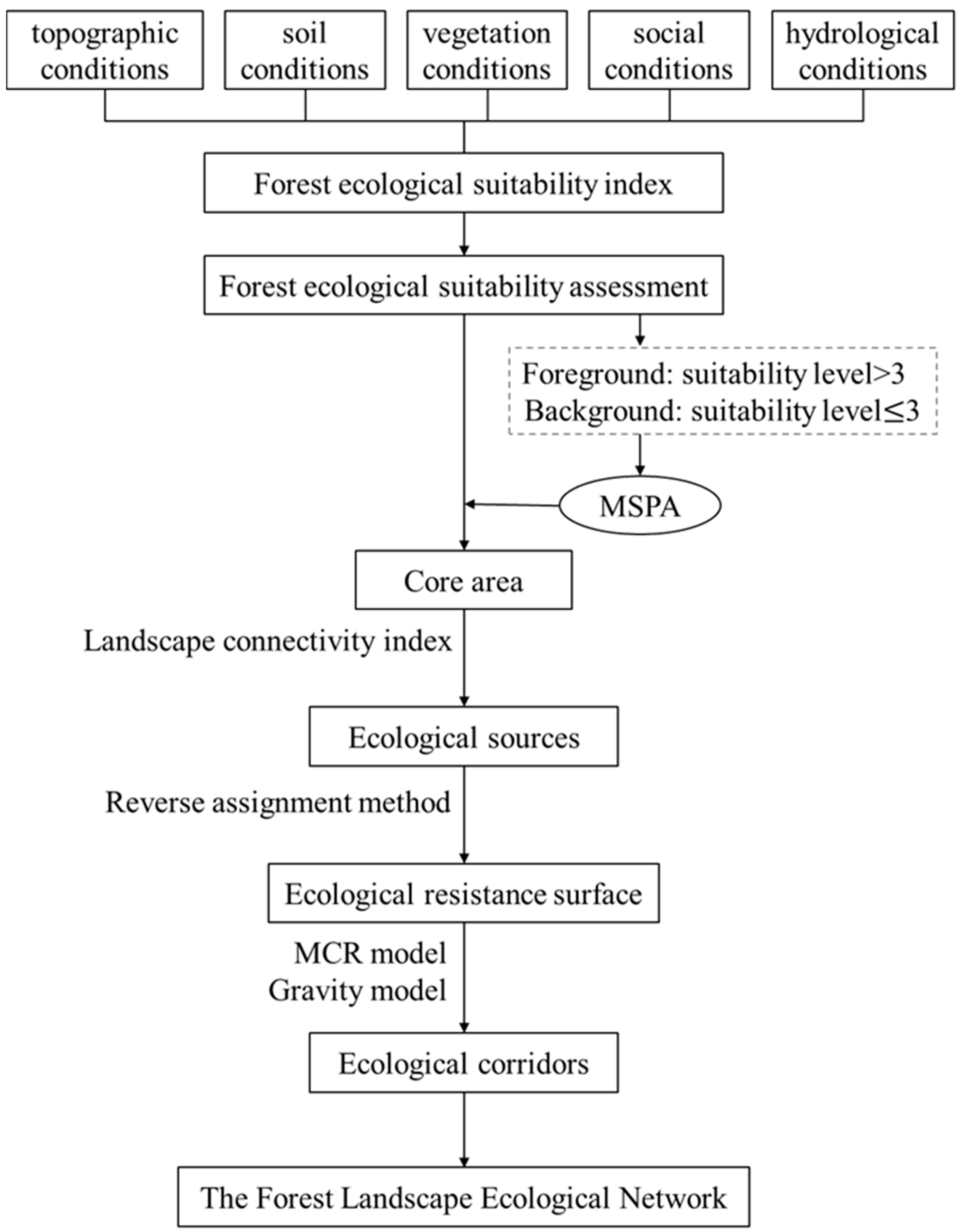
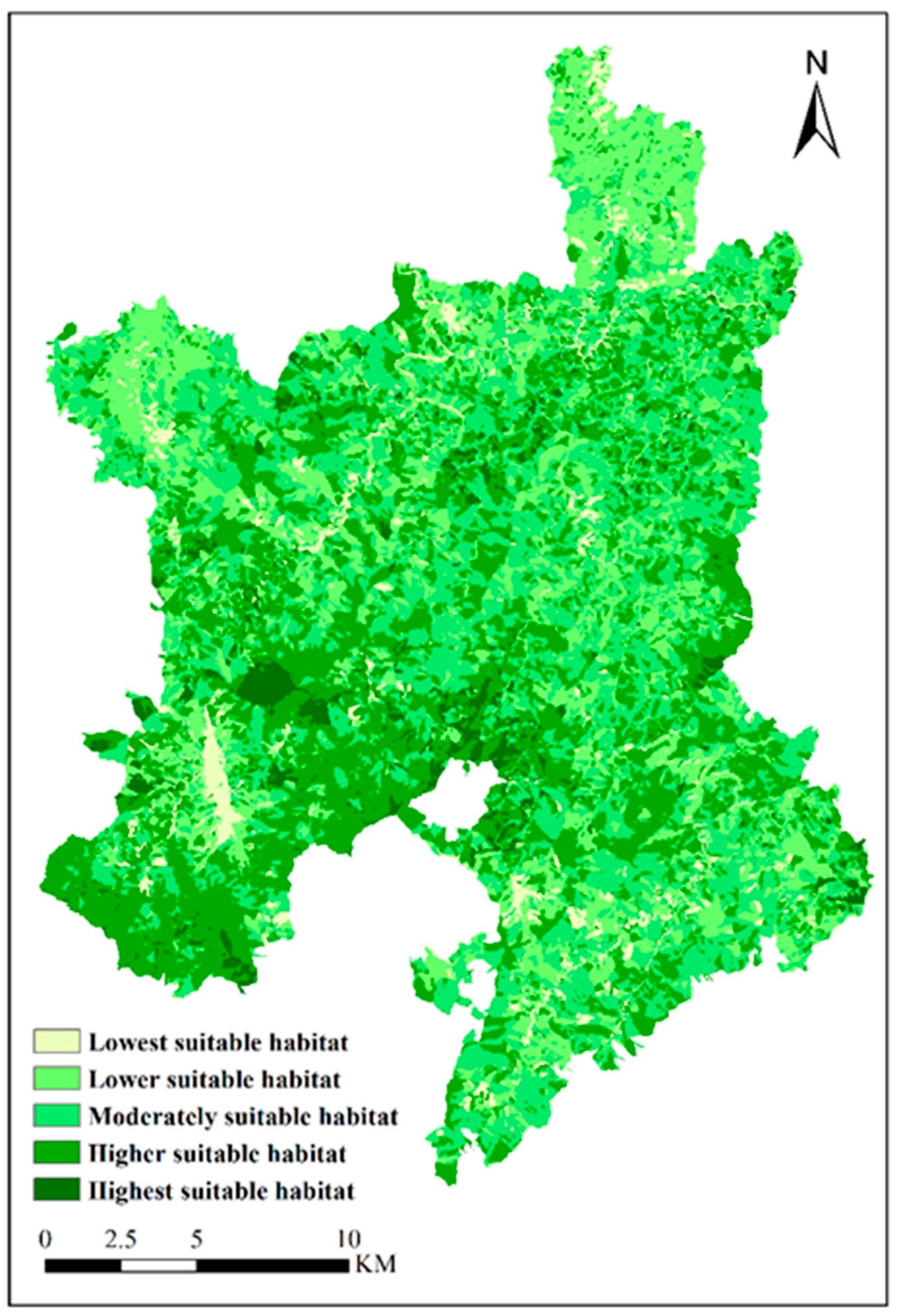
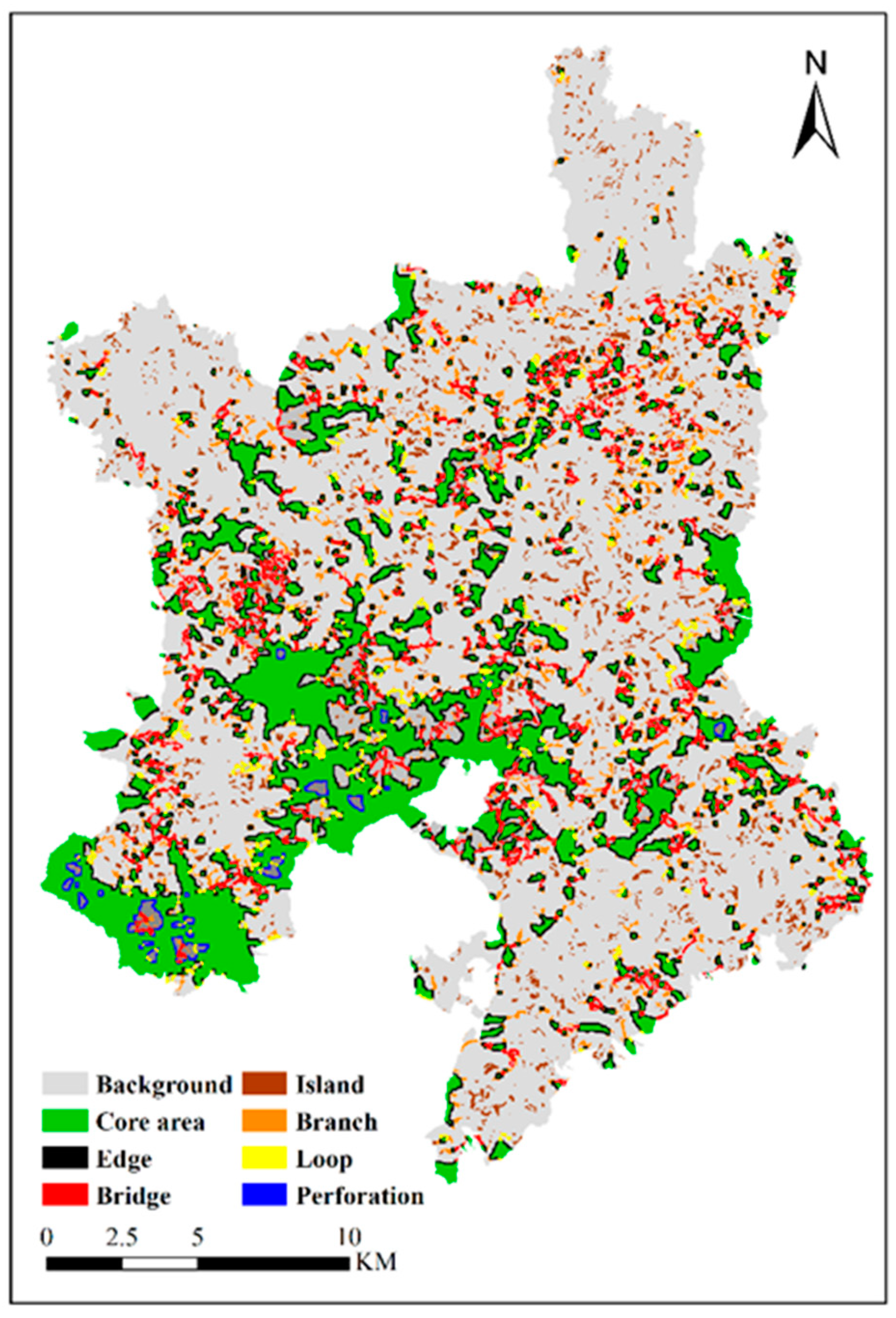
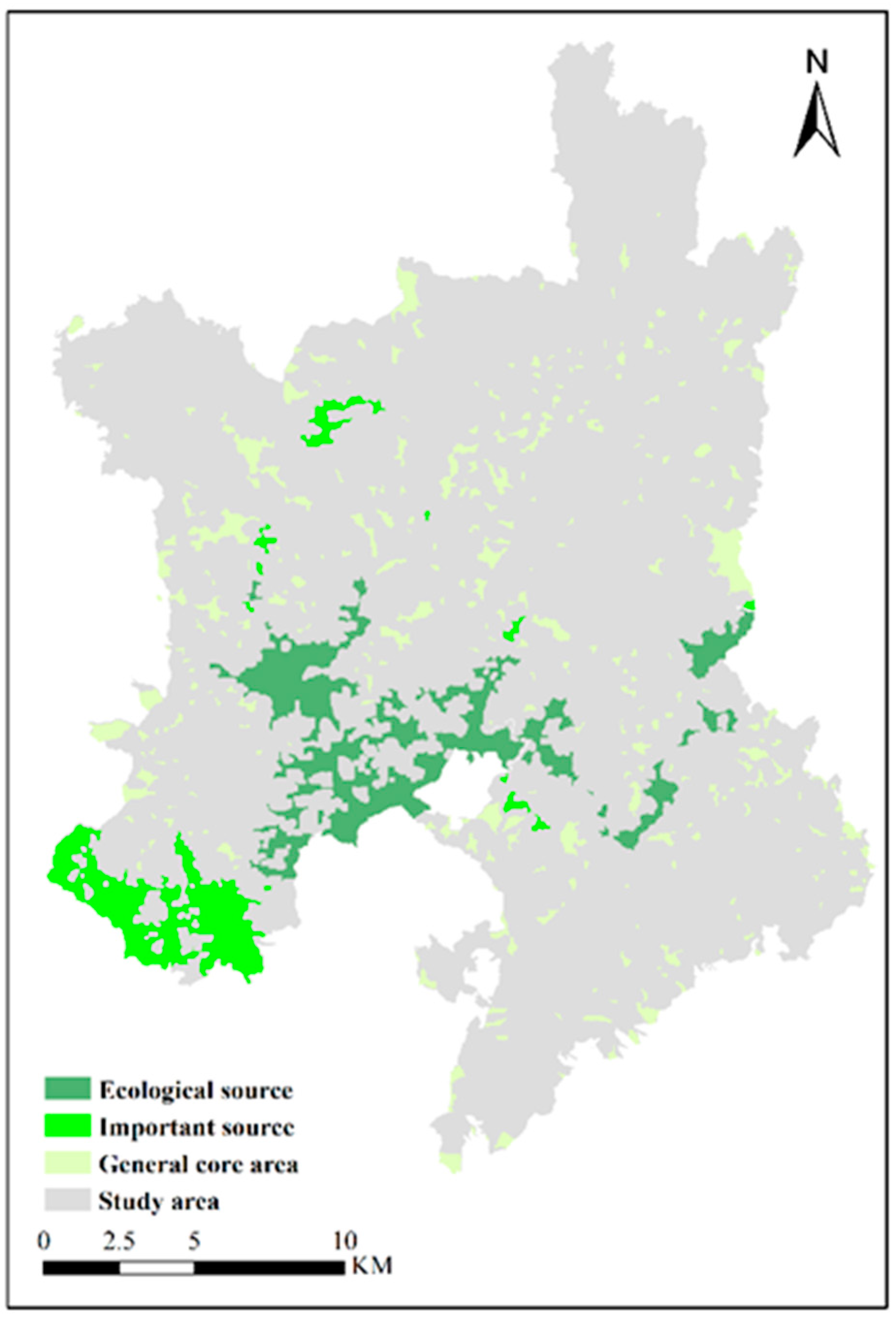
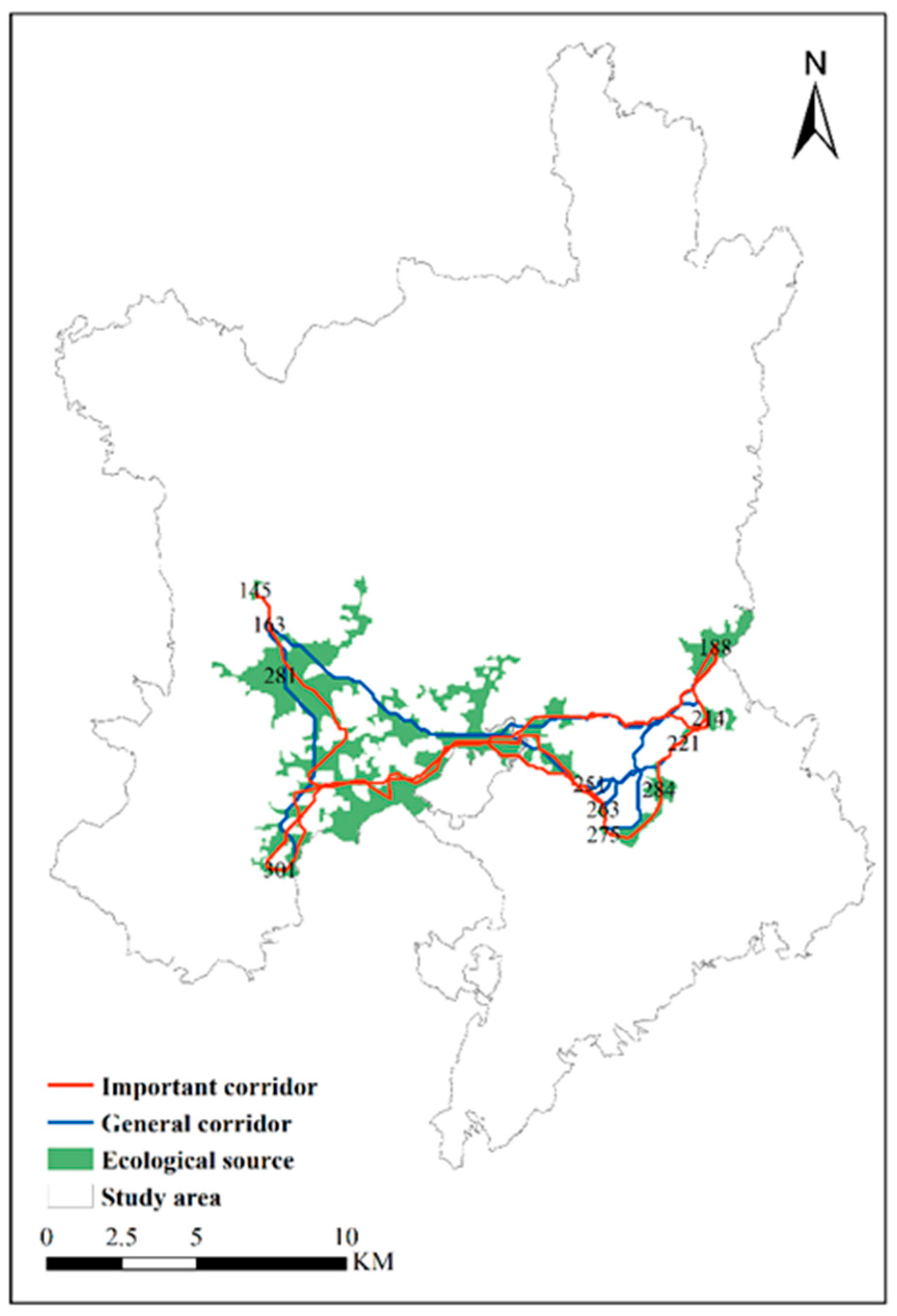
| Impact Factors | Suitability Level | ||||
|---|---|---|---|---|---|
| Level 1 | Level 2 | Level 3 | Level 4 | Level 5 | |
| Slope aspect | Shady slope | Semi-shady slope | Semi-sunny slope | Sunward slope | Flatland |
| Slope position | Up | — | Middle | — | Down |
| Slope (°) | >36 | 26~35 | 16~25 | 6~15 | <5 |
| Soil type | Red soil | — | Yellow soil | — | Yellow brown soil |
| Soil thickness (cm) | <40 | 41~60 | 61~80 | >81 | — |
| Canopy density | — | 1%~20% | 21%~40% | 41%~70% | 71%~100% |
| Origin and forest age | Others | Young plantation forest | Planted middle-aged\Near-Mature Forests | Mature plantation forest | Natural forest |
| Distance from roads (m) | <500 | 501~1000 | 1001~3000 | >3001 | — |
| Distance from villages and towns (m) | <500 | 501~1000 | 1001~3000 | >3001 | — |
| Distance from water (m) | — | >3001 | 1001~3000 | 501~1000 | <500 |
| FESI | Suitable Condition | Area (hm2) | Proportion of Study Area (%) |
|---|---|---|---|
| (0~0.2] | Lowest suitable habitat, where there is a high risk of destruction of the forest landscape | 1967.58 | 0.04 |
| (0.2~0.4] | Lower suitable habitat, where forested landscapes may be destroyed | 12,843 | 0.25 |
| (0.4~0.6] | Moderate suitable habitat, forest landscape can be basically maintained | 18,291.69 | 0.35 |
| (0.6~0.8] | Higher suitable habitat, forest landscape can be maintained | 17,032.68 | 0.33 |
| (0.8~1] | Highest suitable habitat, forest landscape can be fully protected | 1982.07 | 0.04 |
| Landscape Type | Area (hm2) | Proportion of the Suitable Area (%) | Proportion of the Total Area (%) |
|---|---|---|---|
| Core area | 7312.50 | 38.46 | 0.14 |
| Edge | 5972.07 | 31.41 | 0.11 |
| Bridge | 2186.52 | 11.5 | 0.04 |
| Islet | 16,905.98 | 8.92 | 0.03 |
| Branch | 1249.17 | 6.57 | 0.02 |
| Loop | 368.86 | 1.94 | 0.01 |
| Perforation | 230.06 | 1.21 | 0.00 |
| dIIC | dPC | ||||
|---|---|---|---|---|---|
| Cumulative Contribution Value | Number of Patches | Percentage of Patch Numbers | Cumulative Contribution Value | Number of Patches | Percentage of Patch Numbers |
| 0~50% | 1 | 0.29% | 0~50% | 1 | 0.29% |
| 50~90% | 14 | 4.06% | 50~90% | 25 | 7.25% |
| 90~100% | 330 | 95.65% | 90~100% | 319 | 92.46% |
| Node | dIIC | Node | dPC |
|---|---|---|---|
| 301 | 10.45 | 301 | 22.78 |
| 281 | 7.22 | 281 | 10.95 |
| 188 | 2.22 | 284 | 2.80 |
| 77 | 1.58 | 221 | 1.63 |
| 251 | 1.45 | 188 | 1.59 |
| 32 | 0.87 | 214 | 1.43 |
| 24 | 0.83 | 145 | 1.23 |
| 284 | 0.74 | 275 | 1.21 |
| 33 | 0.74 | 251 | 1.16 |
| 221 | 0.58 | 163 | 1.15 |
| Patch Id | 163 | 188 | 214 | 221 | 284 | 251 | 263 | 281 | 275 | 301 |
|---|---|---|---|---|---|---|---|---|---|---|
| 145 | 924.18 | 13.70 | 11.89 | 7.74 | 4.19 | 11.52 | 8.48 | 92.65 | 21.10 | 55.29 |
| 163 | 7.67 | 6.72 | 4.36 | 2.51 | 6.79 | 4.95 | 60.41 | 12.23 | 35.60 | |
| 188 | 1156.79 | 462.88 | 20.28 | 56.75 | 51.32 | 138.94 | 153.63 | 27.87 | ||
| 214 | 4798.22 | 22.32 | 60.44 | 61.38 | 137.17 | 191.87 | 24.26 | |||
| 221 | 20.20 | 53.12 | 55.60 | 88.43 | 178.19 | 16.20 | ||||
| 284 | 378.10 | 102.16 | 153.53 | 162.64 | 9.09 | |||||
| 251 | 1833.62 | 284.08 | 1711.18 | 24.75 | ||||||
| 263 | 170.26 | 6186.85 | 20.69 | |||||||
| 281 | 377.93 | 205.11 | ||||||||
| 275 | 51.06 |
Publisher’s Note: MDPI stays neutral with regard to jurisdictional claims in published maps and institutional affiliations. |
© 2022 by the authors. Licensee MDPI, Basel, Switzerland. This article is an open access article distributed under the terms and conditions of the Creative Commons Attribution (CC BY) license (https://creativecommons.org/licenses/by/4.0/).
Share and Cite
Tang, Q.; Li, J.; Tang, T.; Liao, P.; Wang, D. Construction of a Forest Ecological Network Based on the Forest Ecological Suitability Index and the Morphological Spatial Pattern Method: A Case Study of Jindong Forest Farm in Hunan Province. Sustainability 2022, 14, 3082. https://doi.org/10.3390/su14053082
Tang Q, Li J, Tang T, Liao P, Wang D. Construction of a Forest Ecological Network Based on the Forest Ecological Suitability Index and the Morphological Spatial Pattern Method: A Case Study of Jindong Forest Farm in Hunan Province. Sustainability. 2022; 14(5):3082. https://doi.org/10.3390/su14053082
Chicago/Turabian StyleTang, Qian, Jiping Li, Tao Tang, Pengcheng Liao, and Danmei Wang. 2022. "Construction of a Forest Ecological Network Based on the Forest Ecological Suitability Index and the Morphological Spatial Pattern Method: A Case Study of Jindong Forest Farm in Hunan Province" Sustainability 14, no. 5: 3082. https://doi.org/10.3390/su14053082
APA StyleTang, Q., Li, J., Tang, T., Liao, P., & Wang, D. (2022). Construction of a Forest Ecological Network Based on the Forest Ecological Suitability Index and the Morphological Spatial Pattern Method: A Case Study of Jindong Forest Farm in Hunan Province. Sustainability, 14(5), 3082. https://doi.org/10.3390/su14053082





